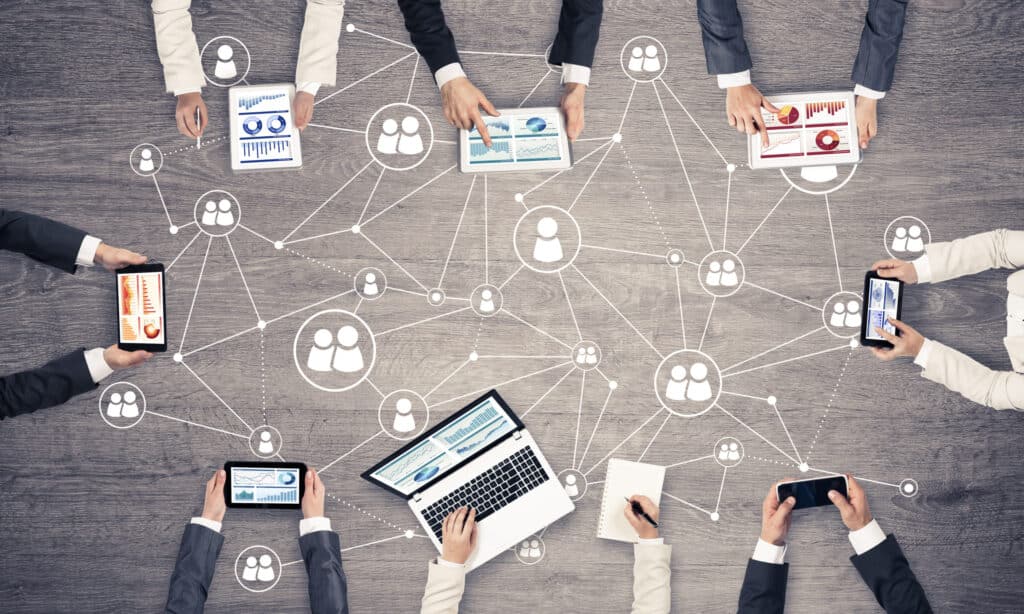Introduction
How Has Technology Improved Communication: The widespread adoption of the internet, both through wired and wireless networks, has eliminated the constraints of geographical boundaries. Today, individuals from different corners of the world can interact in real time, fostering global connections that were previously unimaginable. The proliferation of smartphones, tablets, and other smart devices has placed the power of communication in the palm of our hands. These devices serve as multipurpose communication tools, allowing us to send messages, make calls, and access information with unprecedented ease.
Messaging applications like WhatsApp, WeChat, and Telegram have redefined the way we stay in touch with loved ones and colleagues. Instant messaging, along with features such as voice and video calls, has made long-distance communication more intimate and efficient. Technologies like Zoom and Microsoft Teams have revolutionized the concept of face-to-face meetings. With the ability to conduct high-quality video conferences, organizations have embraced remote work, and individuals have found new ways to stay connected.
AI-driven chatbots and virtual assistants have made it possible to receive instant responses and support for a wide range of queries, improving customer service and information accessibility. Technology has given rise to new forms of communication, from emojis and GIFs to memes, all of which are used to express emotions and ideas quickly and succinctly in the digital realm.

How technology helps with communication?
On the one hand, technology affects communication by making it easier, quicker, and more efficient. It allows you to track conversations and therefore provide better customer service. Tech also makes it easier to gather customer insights and improve the entire customer experience.
Instant Communication: Mobile phones, messaging apps, and email enable instant communication. Individuals can send messages, make calls, or exchange information in real-time, irrespective of their physical location.
Global Reach: The internet and digital communication platforms allow people to connect with others globally. Social media, email, and video conferencing have bridged geographical boundaries, enabling interactions with individuals and cultures worldwide.
Efficiency: Technology streamlines communication processes, making them more efficient. Electronic calendars, scheduling tools, and project management software facilitate organization and coordination of events and tasks.
Accessibility: Digital communication has improved accessibility for individuals with disabilities. Screen readers, speech recognition software, and communication devices have enhanced inclusivity and made it easier for everyone to participate in various forms of communication.
How has technology improved communication worldwide?
Modern communication is instant. You receive the message the other is trying to convey within milliseconds. Wireless signals, satellites, undersea cables, and other advanced technology helps communication by ensuring instant messages and other forms of data to any location on the planet.
Instant Global Connectivity: The internet, coupled with mobile devices, has connected people across continents in real time. Individuals can communicate with friends, family, and colleagues globally through instant messaging, video calls, and social media, transcending geographical boundaries.
Efficient Information Sharing: Digital communication tools have made it incredibly efficient to share information, documents, and media. Email, cloud storage, and file-sharing platforms enable quick and easy exchange of data, fostering collaboration and decision-making among teams, organizations, and individuals.
Crisis Communication: During times of crisis, technology facilitates rapid dissemination of critical information. Authorities and organizations can use websites, social media, emergency alert systems, and messaging apps to provide real-time updates, instructions, and safety alerts to the public.
Global Business and Trade: Technology has transformed international business communication. E-commerce, video conferencing, and supply chain management systems have made it easier for companies to engage in global trade and collaborate with partners and customers around the world.
What is the role of technology in communication?
Changes in communication methods: Technology has introduced new ways of communicating, such as email, instant messaging, and video conferencing. These methods have made communication faster and more convenient, but they have also led to a decrease in face-to-face communication.
Enhancing Accessibility: Technology has made communication more accessible, allowing people to connect and share information regardless of physical location. It has eliminated geographical barriers and facilitated connections across the globe.
Speed and Efficiency: Technology has dramatically improved the speed and efficiency of communication. Messages, documents, and data can be transmitted instantly, reducing delays and enabling real-time interactions.
Expanding Reach: Through digital platforms and the internet, technology has expanded the reach of communication to a global audience. People can engage with individuals, businesses, and organizations from all over the world.
Diverse Communication Tools: Technology provides a wide range of communication tools, including email, instant messaging, video conferencing, social media, and voice calls, offering users flexibility and choice in how they connect with others.
What is technology in communication skills?
Communications technology, also known as information technology, refers to all equipment and programs that are used to process and communicate information. Professionals in the communication technology field specialize in the development, installation, and service of these hardware and software systems.
Digital Writing and Editing: Technology provides word processing software, grammar-checking tools, and digital editing platforms that assist individuals in composing clear, well-structured written messages. This enhances skills in written communication, including emails, reports, and documents.
Social Media and Networking: Platforms like Facebook, LinkedIn, and Twitter enable individuals to connect with others, build professional networks, and share ideas. Technology supports skills in relationship-building, personal branding, and the effective use of social media for communication.
Video Conferencing and Virtual Meetings: Video conferencing tools such as Zoom and Microsoft Teams facilitate virtual face-to-face interactions. These technologies enhance skills in remote communication, active listening, and making effective presentations in a virtual environment.
Email and Messaging Apps: Email and instant messaging apps improve skills in written communication and responsiveness. Features like email etiquette, organization, and the use of appropriate tone are honed through technology.
What type of technology is communication?
What is communication technology? Communication technology is any digital tool you can use to send and receive information. This technology can include software, computer programs, devices and messaging systems. Successful communication technologies are fast, efficient, convenient and easy to use.
Internet and Networking Technology: The internet is the backbone of modern communication. Networking technologies, including wired and wireless connections, underpin email, web browsing, social media, and various online communication platforms.
Telecommunication Technology: Telecommunication encompasses technologies like telephones (landlines and mobile phones), fax machines, and telecommunications infrastructure (cell towers, satellites) that enable voice and data transmission over long distances.
Email and Messaging Technology: Email services and instant messaging apps provide efficient means of written communication. These technologies enable individuals to send messages, documents, and multimedia content.
Social Media Platforms: Social media platforms like Facebook, Twitter, Instagram, and LinkedIn allow users to connect, share content, and engage in conversations with a global audience.
Is technology related to communication?
Communication technology is the transfer of messages (information) among people and/or machines through the use of technology. This processing of information can help people make decisions, solve problems, and control machines. NCTE 4 Use written language to communicate effectively.
Enhancing Communication: Technology provides tools and platforms that enhance the efficiency, reach, and effectiveness of communication. It enables individuals, organizations, and societies to connect, share information, and engage in dialogue more easily and rapidly.
Connectivity: Technological advancements, such as the internet and telecommunications, have transformed how people connect with each other. The internet, along with various networking technologies, allows for global connectivity and communication across vast distances.
Communication Tools: Technology offers a wide range of communication tools, including email, instant messaging apps, video conferencing software, social media platforms, and more. These tools have become integral to modern communication.
Digital Media: Technology enables the creation, sharing, and consumption of digital media, including text, images, videos, and audio. This enhances the expressiveness of communication and the ability to convey messages effectively.
Is technology the main source of communication?
Technology is now the most important communication tool for organizations. Technology has transformed how organizations conduct public relations and marketing, including how they interact with the media and stakeholders.
Global Connectivity: Technology, particularly the internet and digital communication platforms, has connected people worldwide, making it possible to communicate with individuals and groups across geographic boundaries.
Instant Communication: Email, instant messaging apps, and social media platforms offer instant communication, allowing people to exchange messages and information in real time.
Diverse Communication Tools: Technology provides a wide range of communication tools, including voice and video calls, social media, email, and messaging apps, offering users a variety of options for connecting with others.
Remote Work and Collaboration: Technology has enabled remote work and telecommuting, allowing individuals to communicate and collaborate with colleagues, clients, and teams from different locations.
What is an example of technical communication?
Some examples of technical communication are user guides, website content, newsletters, user assistance guides (FAQs), quick reference guides, simulations, and online help. Other examples may include software instructions, medical instructions, training programs, and technical illustrations.
Getting Started: This section includes step-by-step instructions on how to unbox the smartphone, insert the SIM card, charge the battery, and power on the device.
Navigation and Interface: The manual explains the device’s user interface. Including how to navigate the home screen, access apps, and use gestures.
Phone and Messaging: Detailed instructions on making calls, sending text messages, and managing contacts are provided, including information on setting up voicemail.
Internet and Connectivity: It explains how to connect to Wi-Fi networks, use mobile data, and configure Bluetooth and other connectivity features.
Camera and Multimedia: This section covers how to use the camera. Take photos and videos, as well as how to manage and share multimedia content.

Conclusion
The internet has become a bridge that connects people from all corners of the world. We can now effortlessly communicate with friends, family, and colleagues across continents, fostering global communities and a shared sense of humanity. The advent of instant messaging apps and social media platforms has granted us the power of instant communication. We can exchange messages, images, and videos with remarkable speed, creating a sense of immediacy in our interactions.
Smart devices, such as smartphones and tablets, have brought the world to our fingertips. Whether it’s checking emails, making video calls, or accessing information. Our ability to communicate efficiently and conveniently has never been greater. Video conferencing tools have transformed remote work, education, and personal connections. Through high-quality video calls, we can engage in meetings. Celebrate milestones, and maintain a sense of presence, even when separated by vast distances.
The digital age has given us unprecedented access to a wealth of information. Technology has opened doors for individuals with disabilities. Providing adaptive tools and communication aids that facilitate participation in all aspects of life. It promotes inclusivity, diversity, and equal access to information and communication.




